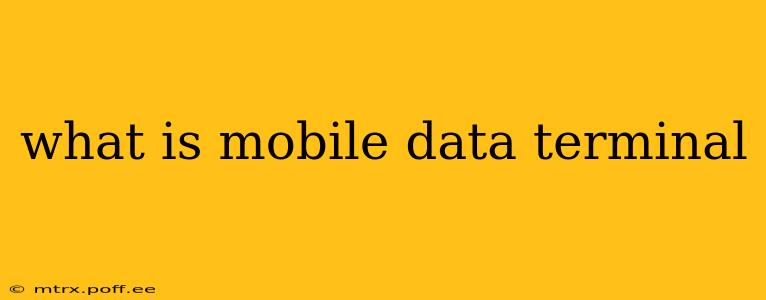A Mobile Data Terminal (MDT) is a device that allows for the collection and transmission of data from a mobile location. Think of it as a mobile computer specifically designed for data-intensive applications requiring real-time connectivity. Unlike a standard laptop or tablet, MDTs are built to withstand harsh environments and are often equipped with specialized features for specific industries. They bridge the gap between mobile operations and centralized data systems.
What are the key features of a Mobile Data Terminal?
MDTs boast a range of features optimized for mobility and data handling. These often include:
- Ruggedized Design: Built to withstand drops, vibrations, and extreme temperatures, making them suitable for various challenging environments, such as construction sites, warehouses, or delivery vehicles.
- Real-time Connectivity: Equipped with cellular, satellite, or Wi-Fi capabilities to ensure continuous data transmission, even in remote locations.
- Specialized Input Methods: MDTs may include features like barcode scanners, RFID readers, fingerprint scanners, or GPS receivers, depending on their intended application.
- Customizable Software: Often tailored to specific industry needs, offering functionalities like dispatching, route optimization, inventory management, and data logging.
- Durable Battery Life: Designed for extended periods of operation without requiring frequent recharging.
- Secure Data Transmission: Employing encryption and other security measures to protect sensitive information.
What are the different types of Mobile Data Terminals?
MDTs come in various forms, each suited to different applications:
- Vehicle-Mounted Terminals: These are permanently installed in vehicles, commonly used in fleet management, transportation, and delivery services.
- Handheld Terminals: Portable and easy to carry, ideal for field workers, delivery personnel, and inventory management in warehouses or retail environments.
- Wearable Terminals: Designed to be worn by workers, often integrated into clothing or protective gear, enabling hands-free operation.
What are the applications of Mobile Data Terminals?
The uses of MDTs are diverse and span many industries:
- Transportation and Logistics: Real-time tracking of vehicles, delivery status updates, route optimization, and driver performance monitoring.
- Field Service Management: Efficient scheduling of technicians, tracking of job progress, and real-time communication with dispatchers.
- Law Enforcement: Data entry, dispatching, and access to critical information in the field.
- Healthcare: Real-time data collection in ambulances, remote patient monitoring, and electronic health record access.
- Retail and Inventory Management: Real-time inventory updates, tracking of assets, and efficient management of stock levels.
- Construction and Field Operations: Tracking equipment location, monitoring progress, and reporting on site activities.
What are the benefits of using Mobile Data Terminals?
The adoption of MDTs offers numerous advantages:
- Improved Efficiency: Automation of data collection and transmission leads to faster processing and decision-making.
- Enhanced Accuracy: Reduced manual data entry minimizes errors and ensures data integrity.
- Real-time Visibility: Provides up-to-the-minute information on operations, enabling proactive management.
- Reduced Costs: Streamlines operations, optimizes resource allocation, and reduces paperwork.
- Better Decision-Making: Access to real-time data empowers informed decisions based on current conditions.
What is the difference between a Mobile Data Terminal and a Tablet?
While both MDTs and tablets can access and process data, key distinctions exist:
- Ruggedness: MDTs are designed for tough environments, surpassing the durability of standard tablets.
- Connectivity: MDTs often prioritize reliable connectivity in challenging locations, whereas tablets may rely more on readily available Wi-Fi.
- Specialized Features: MDTs typically incorporate specialized input methods like barcode scanners or RFID readers, tailoring functionality to specific tasks.
- Software: MDTs usually run custom software optimized for specific industry needs, unlike the general-purpose applications on tablets.
How do Mobile Data Terminals improve operational efficiency?
MDTs significantly enhance operational efficiency by automating data collection, eliminating manual data entry, and providing real-time information. This leads to faster processing, reduced errors, better decision-making, and optimized resource allocation. Ultimately, MDTs streamline workflows and contribute to increased productivity across various industries.
This comprehensive overview provides a thorough understanding of Mobile Data Terminals, their features, applications, and benefits. The information presented aims to satisfy the informational needs of any individual researching MDTs, ensuring clarity and facilitating a solid grasp of the subject matter.
